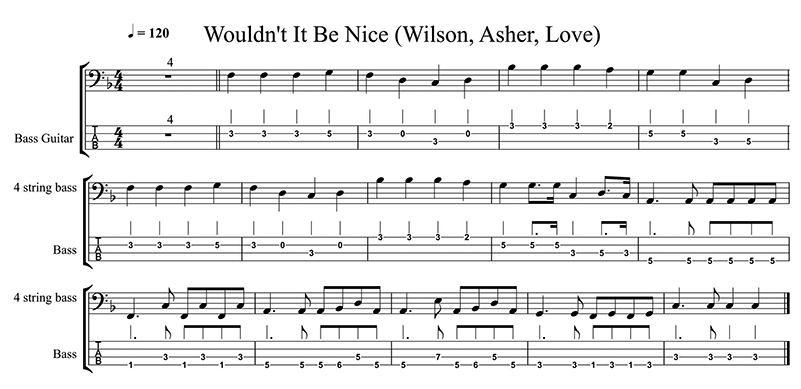Deep Thinking: Carol Kaye Of The Wrecking Crew
Deep Thinking: Carol Kaye Of The Wrecking Crew
In this Deep Thinking session, we are going to look at a couple of tracks recorded by legendary US session bassist, Carol Kaye. Carol was a member of the Wrecking Crew, a team of recording musicians used by the great and the good. The team’s duties included sometimes being used to augment bands playing on their own recordings in the 1960s and 1970s. (But not all, bands such as The Byrds in their early days and The Monkees are only two examples where the Wrecking Crew did almost everything.)
Simon & Garfunkel and The Carpenters are examples of the calibre of successful artists who also called on the Wrecking Crew’s services.
Carol Kaye was not the only electric bassist in the team, there were also Ray Pohlman and Joe Osborne. Carol was originally a jazz guitarist who was called upon to play bass when the regular bassists were not available. (Osborne was himself often doing four sessions a day!) She soon became the ‘first call’ for Phil Spector and Quincy Jones, among others. Legend has it that she played on 10,000 recording sessions, and I have no problem believing that.
She was also used on some famous Motown tracks when the label moved from Detroit to LA. Motown used several bassists, not just James Jamerson. Online chat rooms still rage with arguments about who played on what, the problem being that the Motown producers did not keep records of who was on any of the several versions of each song they released.
Anyway, the Beach Boys tracks we are looking at in this article both come from the Beach Boys’ 1966 album ‘Pet Sounds’, which famously spurred The Beatles to make ‘Sgt. Pepper’s’ in the following year. When ‘Pet Sounds’ was recorded Brian Wilson had stopped touring with the band to concentrate on songwriting and production. The band would record their vocals and a few instrumental overdubs in breaks between tours, but the music was mostly recorded by the Wrecking Crew.
On ‘Pet Sounds’, Carol shares electric bass duties with Ray Pohlman. Lyle Ritz plays double bass on some tracks. Carol has said in interviews that she worked for Brian Wilson on a variety of projects, including one in which Dennis Wilson, the Beach Boys’ drummer, brought Charles Manson and his followers into the studio!
Brian Wilson was unable to score his ideas but would sing the lines he wanted from each musician he was using. Carol is a fluent sight reader but there were many sessions in her career on which she relied on her memory and intuitive skills. Find her discography on Wiki.
I have transposed verses one and two from the album’s opening track Wouldn’t It Be Nice. These are interesting because Wilson, as with other tracks, liked to include notes a whole tone (two frets, above the root notes as well as other notes not normally associated with the usual role of the bass, particularly at that time).
The song starts with a simple 4 beats to the bar (crotchets) before starting to get slightly more syncopated and Carol’s plectrum picking is extremely accurate and high in the mix. Bars seven and ten sound an octave lower that written so I think the electric bass was doubled with another instrument, maybe a baritone sax. In the second to last bar, we again see the use of the note a whole higher that the root note, as used in bars 1 and 9. The whole part can be played between frets one and seven.
The second track, from the same album, is Sloop John B, an old Bahamian folk tune arranged for the Beach Boys by Brian Wilson and Mike Love. It had originally been transcribed by Richard La Galliene in 1916, with lyrics slightly different to those used by Wilson and Love.
The bass line is very complicated throughout most of the tune because they often do not relate to the root of the chords used, and are extremely syncopated with just single snare beats maintaining the tempo.
I have transcribed verse three. Although the song is in Ab, verse three uses the dominant (Eb) as the root of the bass line, another of Wilson’s musical ideas. There are several accents, or pushes, across bars that keep the bassline playing a very prominent role under the lush vocal harmonies, yet the two work well together. Wilson’s choice of notes are not the obvious ones that would be used by most bassists.
The end of the verse breaks down to a familiar crotchet pattern. One would need an amazing memory to remember all of that because several verses have different lines. I am sure, having seen pictures and clips of the sessions, that musicians would have made their own notes. Wilson sometimes did over 30 takes of each tune, mostly at Goldstar Studios, LA, in overnight sessions because the time was cheaper!
Carol is one of my favourite bassists, having played on so many of the tunes of my youth. For those of us who like gear details, she used 1960s Fender Precisions, and replaced them every two years. She also used very heavy La Bella strings and a Fender Bassman amp.
For a chuckle, look up the clip of her teaching Gene Simmons from Kiss. Also, watch the DVD ‘The Wrecking Crew’ (2008).
Dr. Rob Burns is a newly(!) retired Associate Professor in Music at the University of Otago in Dunedin. As a professional studio bassist in the UK, he performed and recorded with David Gilmour, Pete Townsend, Jerry Donahue, Isaac Hayes, Sam and Dave, James Burton, Ian Paice and Jon Lord, Eric Burdon and members of Abba. He played on the soundtracks on many UK television shows, such as Red Dwarf, Mr. Bean, Blackadder, Not the Nine O’Clock News, and Alas Smith and Jones. Rob is a member of Dunedin band, The Verlaines.


